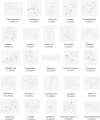Asteraceae Plants as Sources of Compounds Against Leishmaniasis and Chagas Disease
- PMID: 31156427
- PMCID: PMC6530400
- DOI: 10.3389/fphar.2019.00477
Asteraceae Plants as Sources of Compounds Against Leishmaniasis and Chagas Disease
Abstract
Leishmaniasis and Chagas disease cause great impact on social and economic aspects of people living in developing countries. The treatments for these diseases are based on the same regimen for over 40 years, thus, there is an urgent need for the development of new drugs. In this scenario, Asteraceae plants (a family widely used in folk medicine worldwide) are emerging as an interesting source for new trypanocidal and leishmanicidal compounds. Herein, we provide a non-exhaustive review about the activity of plant-derived products from Asteraceae with inhibitory action toward Leishmania spp. and T. cruzi. Special attention was given to those studies aiming the isolation (or identification) of the bioactive compounds. Ferulic acid, rosmarinic acid, and ursolic acid (Baccharis uncinella DC.) were efficient to treat experimental leishmaniasis; while deoxymikanolide (Mikania micrantha) and (+)-15-hydroxy-labd-7-en-17-al (Aristeguietia glutinosa Lam.) showed in vivo anti-T. cruzi action. It is also important to highlight that several plant-derived products (compounds, essential oils) from Artemisia plants have shown high inhibitory potential against Leishmania spp., such as artemisinin and its derivatives. In summary, these compounds may help the development of new effective agents against these neglected diseases.
Keywords: Leishmania spp.; Trypanosoma cruzi; asteraceae plants; leishmanicidal activity; trypanocidal activity; trypanosomatids.
Figures


Similar articles
-
Germacranolide-type sesquiterpene lactones from Smallanthus sonchifolius with promising activity against Leishmania mexicana and Trypanosoma cruzi.Parasit Vectors. 2017 Nov 13;10(1):567. doi: 10.1186/s13071-017-2509-6. Parasit Vectors. 2017. PMID: 29132413 Free PMC article.
-
Bioactive-guided identification of labdane diterpenoids from aerial parts of Aristeguietia glutinosa as anti-Trypanosoma cruzi agents.Nat Prod Commun. 2012 Sep;7(9):1139-42. Nat Prod Commun. 2012. PMID: 23074890
-
Antiprotozoal compounds from Mikania periplocifolia (Asteraceae).Fitoterapia. 2023 Jun;167:105499. doi: 10.1016/j.fitote.2023.105499. Epub 2023 Apr 3. Fitoterapia. 2023. PMID: 37019368
-
Naphthoquinones and Derivatives for Chemotherapy: Perspectives and Limitations of their Anti-trypanosomatids Activities.Curr Pharm Des. 2021;27(15):1807-1824. doi: 10.2174/1381612826666201109111802. Curr Pharm Des. 2021. PMID: 33167829 Review.
-
Discovery of Alternative Chemotherapy Options for Leishmaniasis through Computational Studies of Asteraceae.ChemMedChem. 2021 Apr 20;16(8):1234-1245. doi: 10.1002/cmdc.202000862. Epub 2021 Feb 3. ChemMedChem. 2021. PMID: 33336460 Review.
Cited by
-
Chemical Characterization and Leishmanicidal Activity In Vitro and In Silico of Natural Products Obtained from Leaves of Vernonanthura brasiliana (L.) H. Rob (Asteraceae).Metabolites. 2023 Feb 16;13(2):285. doi: 10.3390/metabo13020285. Metabolites. 2023. PMID: 36837904 Free PMC article.
-
2-aminobenzimidazoles for leishmaniasis: From initial hit discovery to in vivo profiling.PLoS Negl Trop Dis. 2021 Feb 22;15(2):e0009196. doi: 10.1371/journal.pntd.0009196. eCollection 2021 Feb. PLoS Negl Trop Dis. 2021. PMID: 33617566 Free PMC article.
-
Ethnobotanical survey of medicinal and ritual plants utilized by the indigenous communities of Benguet province, Philippines.Trop Med Health. 2024 Sep 10;52(1):59. doi: 10.1186/s41182-024-00624-1. Trop Med Health. 2024. PMID: 39256882 Free PMC article.
-
Phylobioactive hotspots in plant resources used to treat Chagas disease.iScience. 2021 Mar 15;24(4):102310. doi: 10.1016/j.isci.2021.102310. eCollection 2021 Apr 23. iScience. 2021. PMID: 33870129 Free PMC article.
-
The Genus Chiliadenus: A Comprehensive Review of Taxonomic Aspects, Traditional Uses, Phytochemistry and Pharmacological Activities.Plants (Basel). 2025 Jan 13;14(2):205. doi: 10.3390/plants14020205. Plants (Basel). 2025. PMID: 39861558 Free PMC article. Review.
References
-
- Alonso-Castro A. J., Domínguez F., Ruiz-Padilla A. J., Campos-Xolalpa N., Zapata-Morales J. R., Carranza-Alvarez C., et al. . (2017). Medicinal plants from north and central america and the caribbean considered toxic for humans: the other side of the coin. Evid. Based Complement. Alternat. Med. 2017:9439868. 10.1155/2017/9439868 - DOI - PMC - PubMed
-
- Aloui Z., Messaoud C., Haoues M., Neffati N., Bassoumi Jamoussi I., Essafi-Benkhadir K., et al. . (2016). Asteraceae artemisia campestris and artemisia herba-alba essential oils trigger apoptosis and cell cycle arrest in leishmania infantum promastigotes. Evid. Based Complement. Alternat. Med. 2016:9147096. 10.1155/2016/9147096 - DOI - PMC - PubMed
Publication types
LinkOut - more resources
Full Text Sources
Research Materials
Miscellaneous

